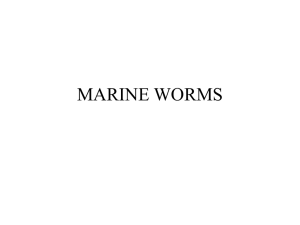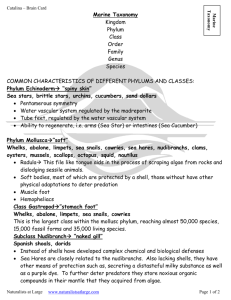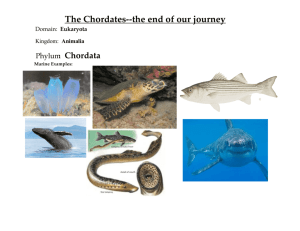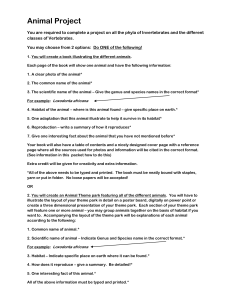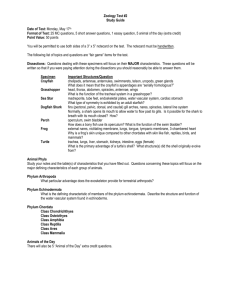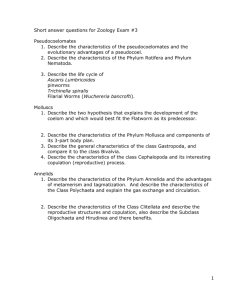Marine Invertebrates A Summary CH7 pg 115 Kingdom Animalia
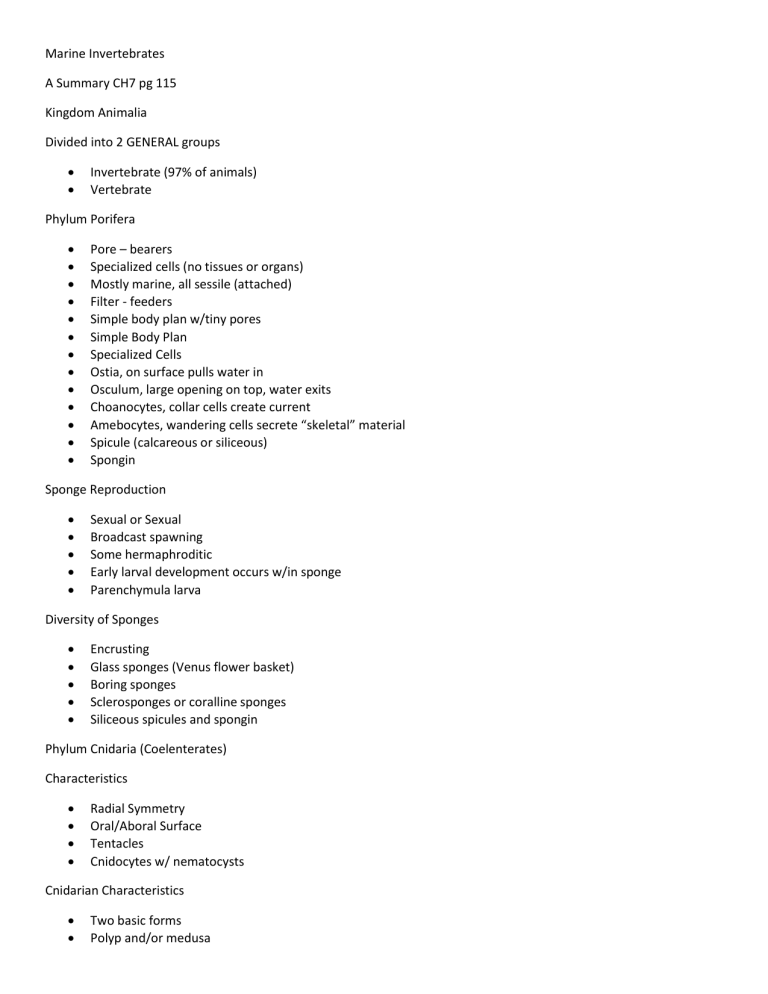
Marine Invertebrates
A Summary CH7 pg 115
Kingdom Animalia
Divided into 2 GENERAL groups
Invertebrate (97% of animals)
Vertebrate
Phylum Porifera
Pore – bearers
Specialized cells (no tissues or organs)
Mostly marine, all sessile (attached)
Filter - feeders
Simple body plan w/tiny pores
Simple Body Plan
Specialized Cells
Ostia, on surface pulls water in
Osculum, large opening on top, water exits
Choanocytes, collar cells create current
Amebocytes, wandering cells secrete “skeletal” material
Spicule (calcareous or siliceous)
Spongin
Sponge Reproduction
Sexual or Sexual
Broadcast spawning
Some hermaphroditic
Early larval development occurs w/in sponge
Parenchymula larva
Diversity of Sponges
Encrusting
Glass sponges (Venus flower basket)
Boring sponges
Sclerosponges or coralline sponges
Siliceous spicules and spongin
Phylum Cnidaria (Coelenterates)
Characteristics
Radial Symmetry
Oral/Aboral Surface
Tentacles
Cnidocytes w/ nematocysts
Cnidarian Characteristics
Two basic forms
Polyp and/or medusa
Planula larva
Two tissue layers
Epidermis (outer)
Gastrodermis (lines the gut)
Mesoglea (gelatinous middle layer)
Types of Cnidarians
Class Hydrozoa
Class Scyphozoa
Class Anthozoa
Class Hydrozoa
Colony w/float
Portuguese – man – of – War (Physalia)
Class Scyphozoa
Rounded Bell
Moon Jelly (Aurelia)
Class Anthozoa
Polyp
Sea Anemone and coral
Phylum Ctenophora
Comb jellies
Radially symmetrical and gelatinous body
8 rows of ciliary combs
Colloblasts, sticky cells
Bilaterally Symmetrical Worms
Phylum Platyhelminthes
Flatworms
Central nervous system
Parasitic
Flukes and tapeworms
Phylum Nemertea
Ribbon worms
Circulatory system
Proboscis
Fleshy tube to entangle prey
Phylum Nematoda
Roundworm
Most parasitic
Phylum Annelida
Segmented worm
Earthworm and many marine worms
Closed circulatory system and gills
Trochophore larva
Polychaetes
Parapodia and setae
Phylum Sipuncula
Peanut worm
Phylum Mollusca
Soft – body covered by mantle
Secretes the shell (some)
Muscular foot (some)
Radula, ribbon of small teeth used to feed
Gills
Body Cavity
Types of Molluscs
Class Gastropoda
Limpet, abalone, nudibranch
Class Bivalvia o Clams, mussels, oysters
Class Cephalopoda o Octopus, squid, cuttlefish
Class Gastropoda
Class Bivalvia
Class Cephalopoda
Other Molluscs
Class Polyplacophora (chiton)
Class Monoplacophora (limpet)
Class Scaphopoda (tusk shells)
Biology of Molluscs
Feeding and Digestion
Nervous System and Behavior
Reproduction and Life History
Separate sexes and some hermaphrodite
Cephalopods (spermatophore)
Trochophore larva into veliger
Phylum Arthropoda
Largest phylum of animals, most on land
Subphylum Crustacea
Bilaterally symmetrical segmented body
Jointed appendages
Exoskeleton
molt
Subphylum Crustacea
Specialized to live in water, most are marine
Copepods, barnacles, amphipods, krill, shrimp, lobsters, crabs, and hermit crabs (to name a few)
Gills and chitin skeleton
Specialized appendages
Two pairs of antennae
Feeding and Digestion
Filter feeders and scavengers
Nervous System
Compound eyes, keen sense of smell, statocysts
Communication
Reproduction
Separate sexes, gametes not shed into water
Nauplius larva
Other Marine Arthropods
Class Merostomata
Living fossils
Class Pycnogonida
Resemble true spiders
Phylum Lophorates
U – shaped gut
Bilateral symmetry
Coelom
Phylum Chaetognatha
Arrow worms
Smallest phyla, all marine
Important predatory plankton
Phylum Echinodermata
“Spiny – skin”
Radially symmetrical (5 parts)
Complete digestive tract, coelom, and an internal skeleton (endoskeleton)
Water – vascular system
Tube feet
Ampullae (muscular sac)
Madreporite
Types of Echinoderms
Class Asteriodea (sea stars)
Class Ophiuroidea (brittle stars)
Class Echinoidea (sea urchins)
Class Holothuroidea (sea cucumbers)
Class Crinoides (feather stars and sea lilies)
Biology of Echinoderms
Feeding and Digestion
Extending or inverting stomach
Nutrients transported by coelomic fluid
Nervous system and Behavior
Little known about nervous system
Reminiscent of nerve net
Turn over and camouflage themselves
Biology of Echinoderms
Reproduction and Life History
Separate sexes
External fertilization
Regeneration
Hemichordates: A “Missing Link”
Evolutionary link between the chordates
Chordates and echinoderms share embryo development
Dorsal hollow nerve cord
Pharyngeal gill slits
Acorn worms (U – shaped gut)
Chordates Without A Backbone
Phylum Chordata
Dorsal hollow nerve chord
Pharyngeal gill slits
Notochord
Post – anal tail
Phylum Chordata
Subphylum Urochordata (tunicate, sea squirts)
Subphylum Cephalochordata (lancelets)
Subphylum Vertebrata (bony or cartilage endoskeleton)


